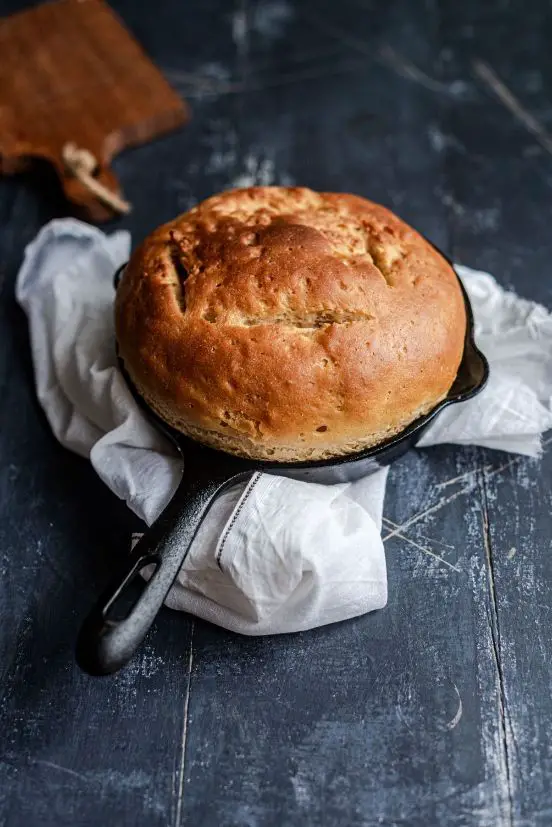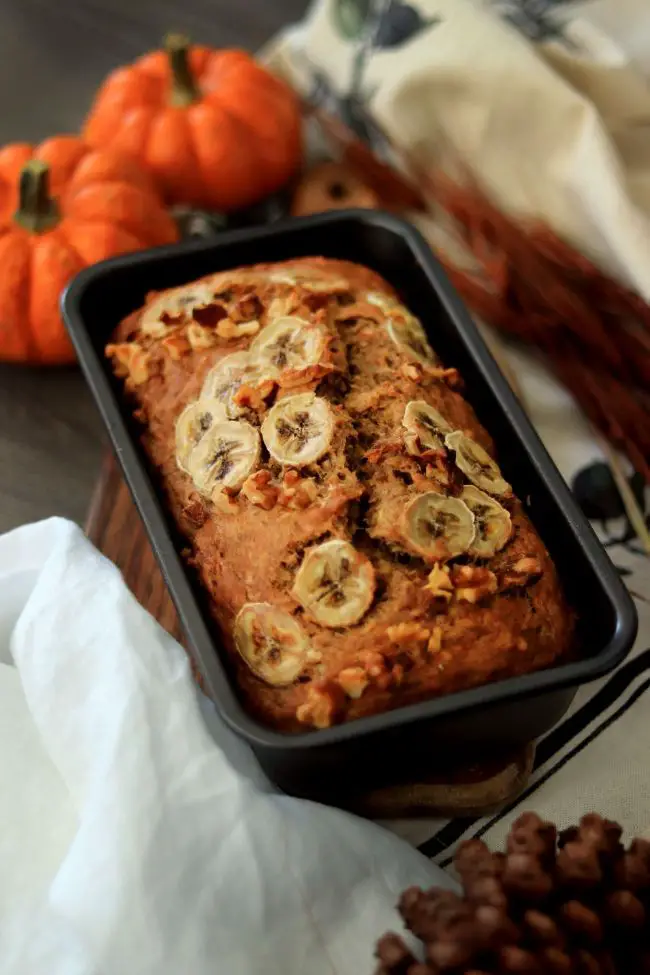Banana bread is a delicious and popular treat enjoyed by many, but it can be disheartening to see cracks forming on its surface.
However, with a few simple adjustments to your baking process, you can prevent these cracks from appearing and achieve a perfectly moist and tender banana bread.
In this article, I’ll reveal 8 common reasons why banana bread cracks and provide helpful tips on how to prevent banana bread from cracking to ensure your loaves come out crack-free.
so, let’s get started.
Why Does My Banana Bread Crack?
Before we delve into the solutions, let’s understand why banana bread cracks.
Several factors can contribute to this mishap. Here are 8 of them:
1. Insufficient Moisture
Insufficient moisture is a common issue that can cause your banana bread to develop cracks.
Moisture plays a vital role in creating a tender and moist texture in banana bread.
When there is not enough moisture, the bread tends to dry out, resulting in unattractive cracks.
2. Overmixing the Batter
Overmixing the batter for your banana bread can lead to excessive development of gluten, which can result in a dense and cracked loaf.
Gluten is a protein that gives structure and texture to baked goods.
When you mix the batter for too long or vigorously, the gluten in the flour becomes overactivated.
This excessive activation causes the gluten to become tough, leading to a dense and cracked outcome.
3. Incorrect Oven Temperature
Baking your banana bread at an incorrect oven temperature can be a contributing factor to the formation of cracks.
When the temperature is set too high, the outer layer of the banana bread can become overly firm and set too quickly, while the interior continues to rise.
This disparity in the baking process can lead to cracks in the banana bread.
To avoid this issue, it is crucial to preheat your oven properly and utilize an oven thermometer to ensure accurate temperature readings.
By doing so, you can achieve optimal baking conditions, allowing the bread to cook evenly and reducing the likelihood of cracks.
4. Improper Banana Mashing
The way in which you mash your bananas can impact the moisture content of your banana bread.
If the bananas are not thoroughly mashed or contain large chunks, it can result in pockets of dryness within the bread, which can ultimately lead to cracks during the baking process.
To prevent this, it is important to mash the bananas until they are completely smooth and free from any lumps.
This ensures that the mashed bananas are evenly distributed throughout the batter, promoting consistent moisture throughout the bread.
By taking the time to properly mash the bananas, you can help prevent the occurrence of cracks and achieve a more desirable texture in your banana bread.
5. Incorrect Pan Size
Using an inappropriate pan size can have negative consequences on the baking process and the final outcome of your bread.

If you opt for a pan that is too small, the batter may overflow as it expands during baking.
This overflow can lead to cracks forming on the surface of the bread.
On the other hand, if you use a pan that is too large, the batter will be spread too thinly, resulting in a loaf that is dry and prone to cracking.
6. Inadequate Leavening Agents
Having an inadequate amount of leavening agents or using expired ones can impede the rising process and contribute to cracks in your banana bread.
Baking soda and baking powder play essential roles in helping the bread rise and achieve a light and fluffy texture.

It is important to ensure that your leavening agents are fresh and active by checking their expiration dates before incorporating them into your recipe.
By using fresh and effective leavening agents, you can promote proper rising and minimize the risk of cracks in your banana bread.
7. Sudden Temperature Changes
When baking banana bread, it’s important to be mindful of sudden temperature changes as they can cause the bread to crack.
For instance, if you remove the bread from a hot oven and place it directly on a cool surface, the abrupt change in temperature can cause the bread to contract rapidly, resulting in unsightly cracks.
To avoid this issue, it is recommended to let your banana bread cool gradually by placing it on a wire rack.
This allows for a more even cooling process, reducing the chances of cracking.
8. Too Much Sugar
The amount of sugar you use in your banana bread recipe plays a significant role in determining its texture and moisture content.

It’s important to strike the right balance as both excessive and insufficient amounts of sugar can negatively affect the final outcome.
If you use too much sugar, it can lead to several issues.
Firstly, excessive sugar can cause the bread to brown excessively, resulting in a dark and brittle crust.
This over-browning can not only affect the appearance of the bread but also contribute to a dry and less desirable texture.
Moreover, the high sugar content can make the bread overly sweet, potentially overpowering the natural flavors of the bananas.
How to Prevent Banana Bread From Cracking – Revealed
To prevent banana bread from cracking, just follow these simple steps:
1. Use Ripe Bananas
Select ripe bananas that have brown spots on the peel. The presence of brown spots indicates that the bananas are fully ripened.
Ripe bananas are softer and sweeter compared to unripe ones, which makes them easier to mash and blend into the batter.

The natural sugars present in ripe bananas add sweetness and contribute to the overall moisture content of the banana bread.
This helps prevent the bread from becoming excessively dry and cracked during baking.
2. Don’t Overmix the Batter
When combining the ingredients for your banana bread, it is crucial to exercise caution and avoid overmixing the batter.
Overmixing can result in excessive gluten development within the bread, leading to a dense and tough texture.
To prevent this outcome, mix the ingredients only until they are just incorporated. It is better to slightly undermix the batter rather than overmix it.
By gently folding and stirring the ingredients together, you can ensure that the finished banana bread will possess a tender and moist texture.
3. Add Moisture-Rich Ingredients
To enhance the moisture content of the banana bread, include ingredients that are rich in moisture.
Examples of such ingredients are yogurt, sour cream, or buttermilk.

These additions not only provide moisture but also contribute to the overall tenderness of the bread.
By maintaining the right balance of moisture throughout the baking process, these ingredients help prevent the banana bread from developing cracks or becoming dry.
Adding moisture-rich ingredients is a great way to ensure delicious and moist banana bread.
4. Use a Lower Oven Temperature
To enhance the quality of your banana bread and minimize the chances of cracks, consider baking at a lower temperature, specifically around 325°F (163°C).
This lower temperature allows the bread to rise more evenly, ensuring a more uniform texture throughout.
Additionally, lower temperatures help to retain moisture within the bread, resulting in a more moist and tender crumb.
5. Be Mindful of Overbaking
Overbaking can lead to dry and cracked banana bread.
To prevent this, keep a close eye on your bread as it bakes, and use a toothpick or cake tester to check for doneness.
Insert the toothpick into the center of the bread—if it comes out with a few moist crumbs clinging to it, the banana bread is ready.
6. Use a Loaf Pan of the Right Size
To prevent cracking caused by improper loaf pan size, it is essential to utilize the correct pan size recommended in the recipe.
If you opt for a pan that is too large, the batter will spread thinly, resulting in overbaking and potential cracking.
Conversely, a pan that is too small can lead to the excessive rising of the bread, causing it to crack as it expands beyond the pan’s capacity.
By following the recipe’s guidance on the right loaf pan size, you can ensure optimal results and minimize the risk of cracks in your bread.
7. Let the Bread Cool Properly
Once the banana bread is baked, allow it to cool in the pan for about 10 minutes.
Then, transfer it to a wire rack to cool completely.
Cooling the bread properly prevents trapped steam from creating additional cracks.
8. Store Banana Bread Correctly
To maintain freshness and prevent cracking after baking, store your banana bread in an airtight container or wrap it tightly with plastic wrap.

Keep it at room temperature for up to 2-3 days or refrigerate it for longer shelf life.
Avoid storing it in direct sunlight or near heat sources.
How to Prevent Banana Bread From Cracking – Conclusion
Banana bread is a delightful treat that anyone can enjoy, whether you’re a seasoned baker or just starting out.
By following the tips and techniques explained in this article, you can prevent banana bread from cracking and achieve beautiful, moist loaves every time.
From adjusting the oven temperature to using ripe bananas and incorporating moisture-rich ingredients, each step plays a crucial role in creating a perfectly baked loaf.
Remember to be patient, experiment, and enjoy the process of baking this beloved treat. Happy baking!

